
Portuguese hip hop, more commonly called hip hop tuga, is the Portuguese variety of hip hop music. It differs from mainstream hip hop because it has strong influences from African music, from Lusophone Africa, reggae, zouk and fado.
Ornatos Violeta are a Portuguese rock band from Porto. The band, often referred to simply as Ornatos, consists of vocalist Manel Cruz, bassist Nuno Prata, guitarist Peixe and drummer Kinörm. Elísio Donas was the band's keyboardist until his death in 2023.
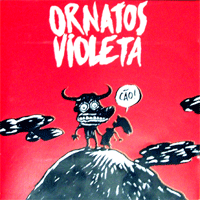
Cão! was the first studio album by Portuguese rock band Ornatos Violeta, released on 15 September 1997 by Polygram. Three singles were released from this album: "Punk Moda Funk", "A Dama do Sinal" and "Mata-me Outra Vez".
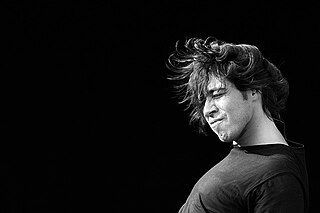
Blind Zero are a Portuguese rock band from the city of Porto. They won the 2003 MTV Europe Music Award for the Best Portuguese Act.
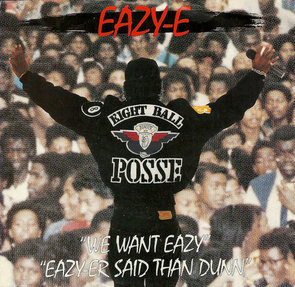
"Eazy-er Said Than Dunn" is a song by American rapper Eazy-E. The song was released as the second single from his debut studio album, Eazy-Duz-It. The track was produced by Dr. Dre and DJ Yella.

"Straight Outta Compton" is a song by American hip hop group N.W.A. It was released on July 10, 1988, as the lead single from their debut album Straight Outta Compton. The song samples "You'll Like It Too" by Funkadelic, "West Coast Poplock" by Ronnie Hudson and the Street People, "Get Me Back on Time, Engine No. 9" by Wilson Pickett, and "Amen, Brother" by the Winstons. It was voted number 19 on About.com's Top 100 Rap Songs, and is ranked number 6 on VH1's 100 Greatest Songs of Hip Hop.

"So Get Up", written and vocalized by Ithaka, is a 1992 spoken-word electronic dance music vocal-poem lyric song more frequently credited to the Portuguese house music production duo Underground Sound of Lisbon, German trance music duo Cosmic Gate, the Spanish group Committee and London-based DJ/producers, Stretch & Vern.

The Reincarnation of a Surfboard is a body of sculpture work created by Ithaka Darin Pappas. The project, which began in 1989 consist of approximately 300 wall-mounted sculptures that have been made using recycled surfboards as raw building material. The series to date has been exhibited on four continents. The most recent solo exhibitions of these works were mesa hosted by WOA - Way Of Arts in Cascais, Portugal in December 2012, by Hurley International in Costa Mesa, California in October 2013 and F+ Gallery in Santa Ana in February 2015.

Stellafly is the second full-length album to be released by Californian Alternative hip hop artist Ithaka.

Ar de Rock is the debut album by Portuguese musician Rui Veloso, released in July 1980 by EMI-Valentim de Carvalho.

Mingos & Os Samurais is the fifth studio album by Portuguese musician Rui Veloso, released on 7 August 1990 by EMI-Valentim de Carvalho. It is a concept album that tells the story of a small suburban band during the 1960s and the 1970s.

The Miracle Mile Shot is an experimental short subject, non-dialogue documentary film based entirely on a single photograph of the influential Gangsta rap group N.W.A. created on November 11, 1988, in the Miracle Mile area of Los Angeles, California, by photographer/artist Ithaka Darin Pappas. The photograph itself, also entitled The Miracle Mile Shot, was captured during a photo session that took place at the photographer's home studio apartment at 6516 1/2 Orange Street, Los Angeles. The short film, screened for the first time at the LAGFF on June 19, 2019, visually tells the story of the most important uses of the photograph in chronological order.

Marta Dias is a São Toméan Portuguese singer of jazz, world music and fado who has recorded several solo albums and has additionally recorded and toured extensively with guitarist António Chainho. She has also appeared on several hip hop releases, including the Ithaka song, Escape From The City Of Angels, which appeared in Columbia Pictures's feature film release, The Replacement Killers in 1998.

General D is a rapper, Hip hop tuga and World music artist. Being the first rapper in Portugal to sign a major record deal, he is considered the Godfather Of Portuguese Hip Hop. Although largely influenced by big name U.S. rap acts such as Public Enemy, Ice Cube and Ice-T, his music carried a distinct African flavor incorporating many live tribal percussion instruments. He recorded two solo albums for EMI-Valentim de Carvalho and has also appeared as a guest on other artists' releases including; Ithaka, Cool Hipnoise, Água d'Amanhã and Pop Dell'Arte.

"Who's the Enemy?" is an English-language alternative hip hop anti-war song by Californian artist/songwriter Ithaka and Brazilian rapper and author, Gabriel o Pensador. The song was originally included on the album, Recorded in Rio, released for the first time in association with Blitz Magazine (Portugal) in 2004. It would later be featured on the soundtrack of the 2006 film, Lost Jewel of the Atlantic, directed by Jacob Holcomb and produced by World Surfing Reserves. The song promotes world peace, containing lyrical references to former U.S. President George W. Bush, The Cold War and global dictators.
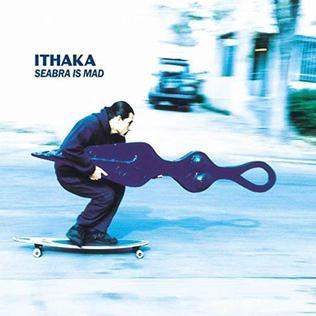
"Seabra Is Mad" is a 1997 drum and bass/alternative rock "story song" by Californian lyricist/vocalist Ithaka. The song was released as the first single from his second studio album Stellafly. Recorded in Portugal, it was produced by Joe Fossard featuring Ewan Butler on guitar and Sergio Nascimento on the chorus drums.
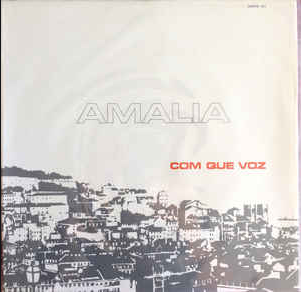
Com Que Voz is a fado album recorded by Amália Rodrigues in January 1969 and released in March 1970 on the EMI and Valentim de Carvalho labels. It reached No. 1 on the Associação Fonográfica Portuguesa (AFP) chart in Portugal. Amália was accompanied on the album by Pedro Leal on viola and José Fontes Rocha on Portuguese guitar.

Os Dias da MadreDeus is the debut studio album by Portuguese group Madredeus. It was released in December 1987 by EMI-Valentim de Carvalho.

Ithaka Darin Pappas, known professionally as Ithaka, is an American-born multidisciplinary artist of Greek ancestry who creates using music, writing, sculpture and photography. He has authored a collection of short stories, entitled Ravenshark Chronicles published in international magazines and periodicals, which have sometimes been the basis for his travel-oriented lyrical content. In a 2005 article for the magazine Waves, journalist Ricardo Macario described Ithaka as "The Miscellaneous Man". In a 2008 review of Ithaka's sixth album Saltwater Nomad, the online surf-culture platform Surfline stated that "the artist effortlessly traverses at ease between all of his choses mediums of expression [music, sculpture, writing and photography]", and that "his life's journey is a soulful balancing act somewhere between the worlds of euphoric creation and aquatic diversion."

Casa Guilhermina is the seventh studio album by Ana Moura. Released on 11 November 2022, the album topped the national sales chart and was named as one of the albums of the year by various reputable Portuguese publications.

















